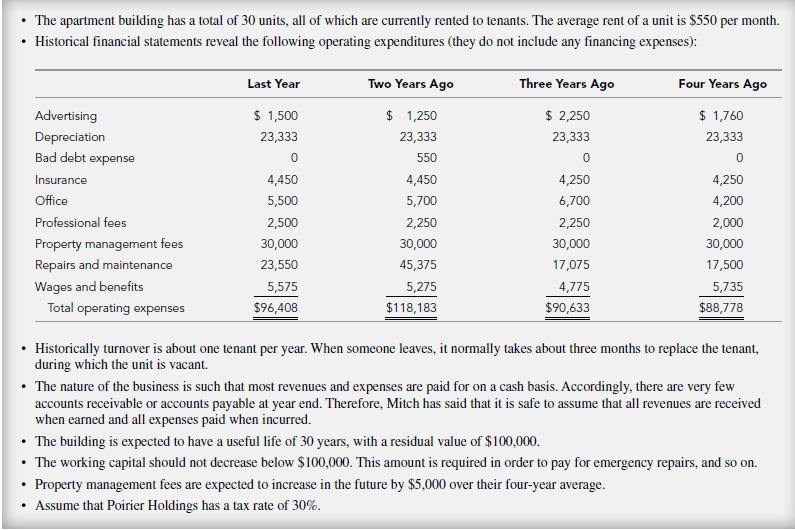Mitch Poirier is considering an investment in a multiple-unit, residential building. The building has 30 units, which are all currently rented to tenants. Further details
Mitch Poirier is considering an investment in a multiple-unit, residential building. The building has 30 units, which are all currently rented to tenants. Further details on the apartment building are provided in Exhibit I. If Mitch decides to proceed with the investment, he will purchase the apartment through a newly formed holding company (Poirier Holdings).
The apartment building, and required initial working capital, will require an investment of $1 million ($900,000 for the building and $100,000 for working capital). Mitch is contemplating various alternatives by which the apartment could be financed. The following four options are available:
1. Borrow $950,000 from the Bank of Calgary, with the remaining $50,000 being financed through personal equity. The loan would be repaid on a monthly basis over a 20-year term with an effective annual interest rate of 6%. The bank would require that the debt to equity ratio not exceed 3.75:1.
2. Borrow $750,000 in the form of an interest-only note from a local, wealthy businessperson, with the rest coming from personal equity. The loan would require annual interest payments, but no principal payments until the end of the 15-year term. Interest is payable at a rate of 7% per annum. The loan covenant stipulates that the debt to equity ratio not exceed 2.75:1.
3. Borrow $600,000 from the Bank of Edmonton, on a 15-year loan with an effective interest rate of 5%. The bank would require a debt to equity ratio of 5:1. An additional $300,000 could be obtained from issuing preferred shares to Joe Poirier, Mitch’s brother. The preferred shares would be cumulative, with a 6% dividend yield. Mitch would finance the remaining $100,000 through common equity.
4. Allow Joe to become a shareholder, whereby both Mitch and Joe would invest $500,000 in common share, equity financing. In this scenario, there would be no long-term debt taken by the Poirier Holdings. Mitch has contacted you, CPA, in order to provide assistance regarding the possible financing alternatives. Mitch would like you to assess the impact of four alternatives on the return on common equity, debt to equity ratio, and ability to pay dividends at the end of each year. Mitch will not proceed with the investment if the debt to equity covenant is likely to be violated, or the return on equity is below 10%. In addition, he would like to be able to draw out dividends
of at least $20,000.
Required
Prepare a report that addresses the concerns of Mitch Poirier by assessing the four financing alternatives and recommending a source of financing. A pro forma statement of financial position under each alternative for the future periods should be included in your report.

The apartment building has a total of 30 units, all of which are currently rented to tenants. The average rent of a unit is $550 per month. Historical financial statements reveal the following operating expenditures (they do not include any financing expenses): Advertising Depreciation Bad debt expense Insurance Office Professional fees Property management fees Repairs and maintenance Wages and benefits Total operating expenses Last Year $ 1,500 23,333 0 4,450 5,500 2,500 30,000 23,550 5,575 $96,408 Two Years Ago $ 1,250 23,333 550 4,450 5,700 2,250 30,000 45,375 5,275 $118,183 Three Years Ago $ 2,250 23,333 0 4,250 6,700 2,250 30,000 17,075 4,775 $90,633 Four Years Ago $ 1,760 23,333 0 4,250 4,200 2,000 30,000 17,500 5,735 $88,778 Historically turnover is about one tenant per year. When someone leaves, it normally takes about three months to replace the tenant, during which the unit is vacant. Property management fees are expected to increase in the future by $5,000 over their four-year average. Assume that Poirier Holdings has a tax rate of 30%. The nature of the business is such that most revenues and expenses are paid for on a cash basis. Accordingly, there are very few accounts receivable or accounts payable at year end. Therefore, Mitch has said that it is safe to assume that all revenues are received when earned and all expenses paid when incurred. The building is expected to have a useful life of 30 years, with a residual value of $100,000. The working capital should not decrease below $100,000. This amount is required in order to pay for emergency repairs, and so on.
Step by Step Solution
3.29 Rating (152 Votes )
There are 3 Steps involved in it
Step: 1
The required rate of return is 10 1 Borrow 950000 from the Bank of Calgary with the remaining 50000 being financed through personal equity The loan would be repaid on a monthly basis over a 20year ter...
See step-by-step solutions with expert insights and AI powered tools for academic success
Step: 2

Step: 3

Ace Your Homework with AI
Get the answers you need in no time with our AI-driven, step-by-step assistance
Get Started


